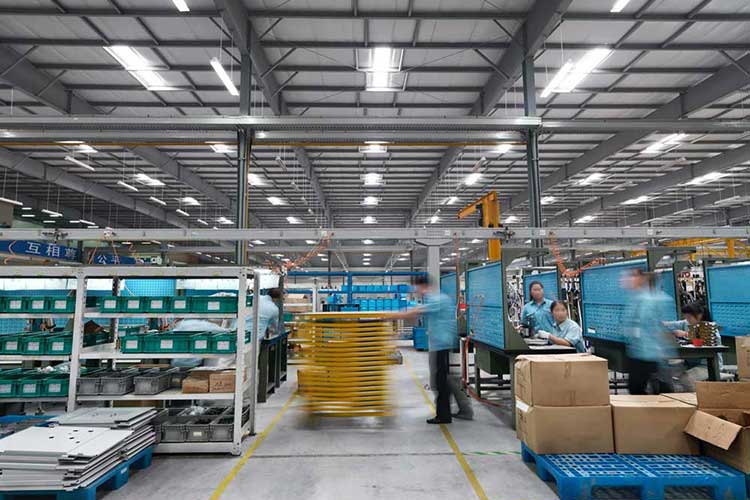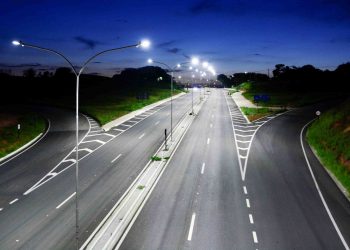
Understand how to define the maintenance factor for lighting projects.
Knowing the maintenance factor for lighting is essential for those who opt for implementing a lighting project. It is also important to pay attention to various relevant details, such as hiring reliable professionals specialized in this field and ensuring the durability and efficiency of the luminaires and other devices.
In this article, we will explain what the maintenance factor is for industrial LED lighting, its purpose, and when it is used. We will also show how to define it for lighting projects and its importance for companies. Here, you will learn how to calculate the maintenance factor for lighting in the most appropriate way to deliver better quality in your public lighting projects.
Do you want to understand the consequences of using an inappropriate maintenance factor? Keep reading!
What is the maintenance factor?
The maintenance factor for lighting is a method used to predict the long-term maintenance of the luminous flux and initial properties established in the lighting project for the environment. It also predicts the best time to replace the luminaires to maintain the ideal brightness. By applying it, specialized professionals can guarantee their services in the long term.
Another factor that can influence the calculation of the maintenance factor is a routine cleaning of the luminaires, according to the type of environment in which they are located. To maintain the luminous flux established at the beginning of the project, it is important that the lenses and diffusers of the luminaires are free of dust and residues.
In more hostile environments, such as tire and rubber material factories, constant soot must be considered in calculating the maintenance factor to maintain the ideal illuminance levels for work activity development. This type of information is crucial for good performance and longer lifespan of the lighting project.
LED luminaires have a lifespan up to 3 times longer than conventional lighting systems, which means they take much longer to depreciate their light production, and for this reduction to be perceptible to the human eye.
The time at which this reduction in luminous flux occurs is known from tests to which the products are subjected, and the results are demonstrated in LM-80, TM-21, L-70, and LM-79 reports. These documents are of great importance in defining product quality and establishing the maintenance factor.
What is the importance of this factor used in industrial LED lighting projects?
An ideal lighting system should maintain the initial illuminance level forever. However, this is not what happens in practice, as there is a decrease in the luminous flux of the devices, which age, are influenced by dust, dirt, and so on. Thus, the average illuminance is no longer sufficient for the predetermined level.
For this reason, at the beginning of any lighting project, attention must be paid to the maintenance factor for lighting, so that the minimum illuminance required by the environment is maintained over the luminaire’s useful life. The reduction in the amount of light that reaches a surface is the depreciation that becomes a problem for companies.
Furthermore, the lighting project should be composed of high-quality products, considering that low-quality and untraceable luminaires can quickly depreciate, causing losses to the lighting system. LED devices and luminaires do not wear out and do not affect luminosity.
How to calculate this value properly for indoor and public lighting?
The lighting designer will be responsible for defining the calculation methods applied in their projects. To understand this calculation, let’s provide a practical example.
Suppose you have implemented a system in your company that depreciates 30% over its useful life. It can be said that your maintenance factor would be 0.70, according to the following calculation:
- Maintenance factor = 1 – expected depreciation
- Maintenance factor = 1 – 0.30 = 0.70
The solution to this problem is to evaluate these conditions when designing the lighting project. For example, a company needs a maintained illuminance of 100 lux, so the designer decides to add 43% and work with a percentage of 143%. This value gradually decreases over time due to depreciation.
If the standard stipulates that an area must have at least 30 lux, the project can never have an average below this parameter at the end of the life cycle of its devices. To compensate for natural loss, the maintenance factor is applied, which serves to predict the future of maintained illuminance based on the initial properties of a system.
Manufacturers of lighting devices typically use a maintenance factor of 0.80. Therefore, the lighting can be 25% greater than what was designed by the specialist at the time of installation. Many devices lose 20% of their brightness after 30,000 hours of use, but it is possible to find devices with higher quality.
The best components currently available on the market have a life span of over 100,000 hours. For example, SX products, for the most part, exceed 100,000 hours of life span. With the increase in energy efficiency and durability of LED devices, the maintenance factor tends to decrease according to the evolution of technology and the use of better quality products.
What are the consequences of using an inappropriate maintenance factor?
If the luminaire loses efficiency or has a short lifespan, the level of illuminance will fall below the recommended level in a short time and replacement will be needed sooner. The consequences of using an appropriate maintenance factor include increased costs for purchasing new products.
When a project is not done properly, taking into account the characteristics of the environment, the result can be a system with poor light distribution and low levels of illuminance. This can cause visual fatigue, headaches, burning, redness in the eyes, and other difficulties for employees.
Finally, the use of an inappropriate maintenance factor affects the performance of workers who cannot achieve the expected performance. Low or excessively high luminosity levels also affect the psychological health of employees, causing fatigue and leading to occupational diseases. It may also result in inefficient use of technology, leading to increased energy consumption and often unexpected replacements of luminaires.
Now that you understand how to define the industrial LED maintenance factor for lighting projects, SX Lighting is a specialized company that provides LED lighting solutions for industries, courts, gyms, public roads, airports, condominiums, gas stations, churches, logistics warehouses, and much more. The company’s professionals provide lighting design services for all market segments.
Would you like to obtain more information about the maintenance factor? Contact us and ask for assistance from a specialized professional!
Share






